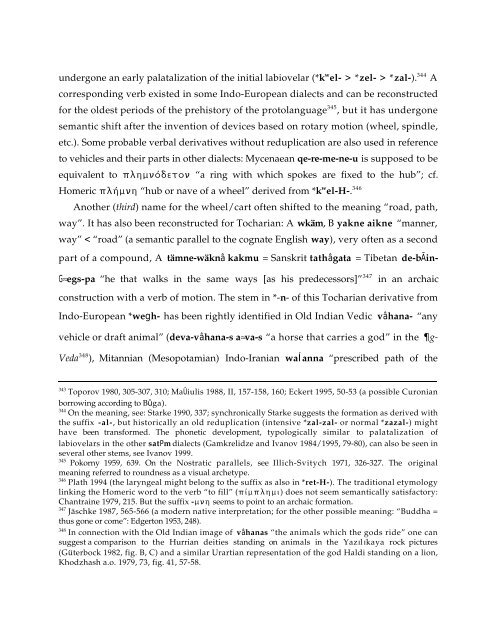Comparative Notes on Hurro-Urartian, Northern Caucasian
Comparative Notes on Hurro-Urartian, Northern Caucasian
Comparative Notes on Hurro-Urartian, Northern Caucasian
You also want an ePaper? Increase the reach of your titles
YUMPU automatically turns print PDFs into web optimized ePapers that Google loves.
underg<strong>on</strong>e an early palatalizati<strong>on</strong> of the initial labiovelar (*k w el- > *zel- > *zal-). 344 A<br />
corresp<strong>on</strong>ding verb existed in some Indo-European dialects and can be rec<strong>on</strong>structed<br />
for the oldest periods of the prehistory of the protolanguage 345 , but it has underg<strong>on</strong>e<br />
semantic shift after the inventi<strong>on</strong> of devices based <strong>on</strong> rotary moti<strong>on</strong> (wheel, spindle,<br />
etc.). Some probable verbal derivatives without reduplicati<strong>on</strong> are also used in reference<br />
to vehicles and their parts in other dialects: Mycenaean qe-re-me-ne-u is supposed to be<br />
equivalent to plhmnÒdet<strong>on</strong> “a ring with which spokes are fixed to the hub”; cf.<br />
Homeric plÆmnh “hub or nave of a wheel” derived from *k w el-H-. 346<br />
Another (third) name for the wheel/cart often shifted to the meaning “road, path,<br />
way”. It has also been rec<strong>on</strong>structed for Tocharian: A wkäm, B yakne aikne “manner,<br />
way” < “road” (a semantic parallel to the cognate English way), very often as a sec<strong>on</strong>d<br />
part of a compound, A tämne-wäknâ kakmu = Sanskrit tathâgata = Tibetan de-bÃin-<br />
G≈egs-pa “he that walks in the same ways [as his predecessors]” 347 in an archaic<br />
c<strong>on</strong>structi<strong>on</strong> with a verb of moti<strong>on</strong>. The stem in *-n- of this Tocharian derivative from<br />
Indo-European *we´gh- has been rightly identified in Old Indian Vedic vâhana- “any<br />
vehicle or draft animal” (deva-vâhana-s a≈va-s “a horse that carries a god” in the g-<br />
Veda 348 ), Mitannian (Mesopotamian) Indo-Iranian waÍanna “prescribed path of the<br />
343 Toporov 1980, 305-307, 310; MaÛiulis 1988, II, 157-158, 160; Eckert 1995, 50-53 (a possible Cur<strong>on</strong>ian<br />
borrowing according to Bûga).<br />
344 On the meaning, see: Starke 1990, 337; synchr<strong>on</strong>ically Starke suggests the formati<strong>on</strong> as derived with<br />
the suffix -al-, but historically an old reduplicati<strong>on</strong> (intensive *zal-zal- or normal *zazal-) might<br />
have been transformed. The ph<strong>on</strong>etic development, typologically similar to palatalizati<strong>on</strong> of<br />
labiovelars in the other satPm dialects (Gamkrelidze and Ivanov 1984/1995, 79-80), can also be seen in<br />
several other stems, see Ivanov 1999.<br />
345 Pokorny 1959, 639. On the Nostratic parallels, see Illich-Svitych 1971, 326-327. The original<br />
meaning referred to roundness as a visual archetype.<br />
346 Plath 1994 (the laryngeal might bel<strong>on</strong>g to the suffix as also in *ret-H-). The traditi<strong>on</strong>al etymology<br />
linking the Homeric word to the verb “to fill” (p¤mplhmi) does not seem semantically satisfactory:<br />
Chantraine 1979, 215. But the suffix -mnh seems to point to an archaic formati<strong>on</strong>.<br />
347 Jäschke 1987, 565-566 (a modern native interpretati<strong>on</strong>; for the other possible meaning: “Buddha =<br />
thus g<strong>on</strong>e or come”: Edgert<strong>on</strong> 1953, 248).<br />
348 In c<strong>on</strong>necti<strong>on</strong> with the Old Indian image of vâhanas “the animals which the gods ride” <strong>on</strong>e can<br />
suggest a comparis<strong>on</strong> to the Hurrian deities standing <strong>on</strong> animals in the YazIlIkaya rock pictures<br />
(Güterbock 1982, fig. B, C) and a similar <strong>Urartian</strong> representati<strong>on</strong> of the god Haldi standing <strong>on</strong> a li<strong>on</strong>,<br />
Khodzhash a.o. 1979, 73, fig. 41, 57-58.





